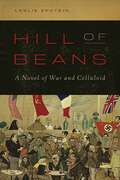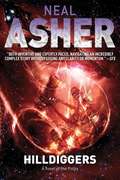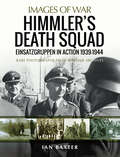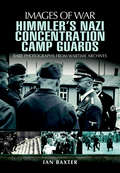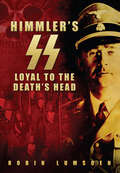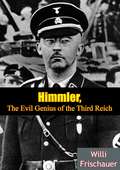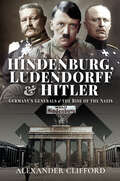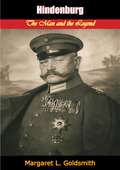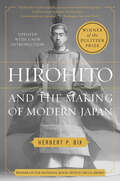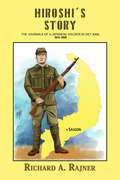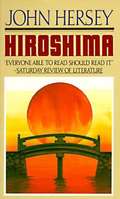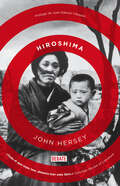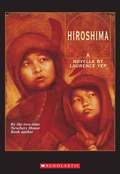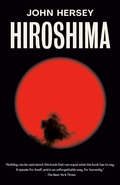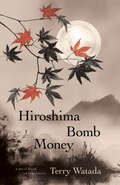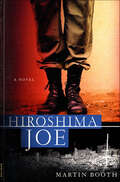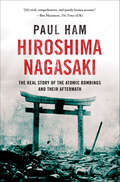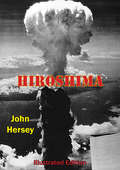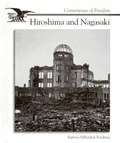- Table View
- List View
Hill of Beans: A Novel of War and Celluloid
by Leslie EpsteinThe film Casablanca opens with the words, &“With the coming of the Second World War, many eyes in imprisoned Europe turned hopefully, or desperately, toward the freedom of the Americas.&” Leslie Epstein&’s Hill of Beans is the story of how one nation, one industry, and in particular one man responded to that desperate hope. That man is Jack Warner. His impossible goal is to make world events—most importantly, the invasion of North Africa by British and American forces in 1942—coincide with the release of his new film about a group of refugees marooned in Morocco. Arrayed against him are Stalin and Hitler, as well as Josef Goebbels, Franklin Roosevelt, a powerful gossip columnist, and above all a beautiful young woman with a terrible secret. His only weapons are his hutzpah and his heroism as he struggles to bring cinema and city, conflict and conference together in an epic command performance.Hill of Beans is the novel that Leslie Epstein—the son and nephew of Philip and Julius Epstein, the screenwriters of Casablanca—was born to write.
Hilldiggers
by Neal AsherDuring a war between two planets in the same solar system - each occupied by adapted humans - what is thought to be a cosmic superstring is discovered. After being cut, this object collapses into four cylindrical pieces, each about the size of a tube train. Each is densely packed with either alien technology or some kind of life. They are placed for safety in three ozark cylinders of a massively secure space station. There a female research scientist subsequently falls pregnant, and gives birth to quads. Then she commits suicide - but why? By the end of the war one of the contesting planets has been devastated by the hilldiggers - giant space dreadnoughts employing weapons capable of creating mountain ranges. The quads have meanwhile grown up and are assuming positions of power in the post-war society. One of them will eventually gain control of the awesome hilldiggers . . .
Himmler's Death Squad: Einsatzgruppen in Action, 1939–1944 (Images of War)
by Ian BaxterThis WWII pictorial history offers an unsettling up-close account of the Nazi death squads committing mass murder on the Eastern Front.The murderous activities of Himmler’s Einsatzgruppen – or death squads—rank high among the horrors of the Nazi regime during the Second World War. As the Waffen-SS and Wehrmacht advanced into Eastern Europe and Soviet Russia, these hand-picked groups followed in their wake, committing mass murder of civilians.Their killing in occupied territories will never be accurately quantified but is likely to have exceeded two million people, including some 1.3 million of the 6,000,00 Jews who perished in the Holocaust.The graphic and shocking photographs in this Images of War book show Einsatzgruppen operations, including the hunt for and rounding up of civilians, communists, Jews and Romani people. It also shows the active support given to the Einsatzgruppen by SS and Wehrmacht units. The latter strenuously denied any collusion, but the photographic evidence here refutes this.
Himmler's Nazi Concentration Camp Guards: Rare Photographs from Wartime Archives (Images of War)
by Ian Baxter&“A chilling study of the . . . recruitment, indoctrination and performance of those responsible for the guarding of concentration camp inmates.&”—Inscale.org The conversion of human beings into murderers and individuals routinely carrying out appalling acts of cruelty are bound to be shocking. But it happened under the Third Reich on a massive scale. This book follows the development of concentration camps from the early beginnings in the 1930s (Buchenwald, Sachsenhausen etc.), through their establishment in the conquered territories of Poland and Czechoslovakia to the extermination camps (Dachau, Auschwitz). In parallel, it describes, using original source material, the behavior of the guards who became in numerous cases immune to the horrors around them. This is well borne out by the conduct of the guards during the Liberation process, which is also movingly described using numerous personal accounts of shocked Allied personnel. Of the 55,000 Nazi concentration camp guards, some 3,700 were women. The book studies their behavior with examples along with that of their male counterparts. &“These are everyday pictures of sadistic murderers. Ian Baxter should be commended on this book. The concentration camps of the Second World War should never be pushed to the back of our minds. It happened and we should remember it so that it can never be allowed to happen again.&”—WW2 Connection
Himmler's SS: Loyal to the Death's Head
by Robin LumsdenThe real story of the SS, unlike its popular mythology, is so complex as to almost defy belief: it is a tale of intrigue and nepotism, of archaeology and Teutonism, of art and symbolism.Himmler's SS is a story of street fighters and convicted criminals becoming Ministers of State and police commanders; the story of charitable works and mass extermination being administered from the same building; the story of boy generals directing vast heterogeneous armies on devastating campaigns of conquest. Here, indeed, fact is stranger than fiction. Himmler's SS looks at the wide-ranging effects that the SS had on the Police, racial policies, German history, education, the economy and public life, as well as the uniforms and regalia which were carefully designed to set Himmler's men apart as the new elite in Third Reich society. Fully illustrated, this book is an authoritative history of the SS and as such will appeal to all with an interest in Hitler's Third Reich.
Himmler: The Evil Genius of the Third Reich
by Willi FrischauerOriginally published in 1953, this masterly study of Heinrich Himmler is a forceful, dispassionate analysis of a man who rose from obscure beginnings as an agricultural student to a position of almost absolute power, until, in the Nazi twilight, he challenged Hitler himself.Outwardly insignificant, diffident--possessing neither the flamboyance of Goering nor the incisiveness of Goebbels--Himmler, head of the dreaded Secret Police, yet made himself the man most feared in the Nazi hierarchy--and as much by his 'friends' as his enemies. Only when the incredible facts about Himmler's extraordinary hold over his colleagues became known were the full depths of the infamy to which Nazism had brought Germany revealed.Based on journalist Willi Frischauer's unique knowledge of the background and sequence of events which gave rise to the Hitler regime, he manages to unearth the evidence, building up, stone by stone, the mosaic of Himmler's true portrait.A fully documented and unforgettable narrative.
Hindenburg, Ludendorff and Hitler: Germany's Generals and the Rise of the Nazis
by Alexander CliffordThey are two of twentieth-century history’s most significant figures, yet today they are largely forgotten – Paul von Hindenburg and Erich Ludendorff, Germany’s First World War leaders. Although defeat in 1918 brought an end to their ‘silent dictatorship’, both generals played a key role in the turbulent politics of the Weimar Republic and the rise of the Nazis. Alexander Clifford, in this perceptive reassessment of their political careers, questions the popular image of these generals in the English-speaking world as honourable ‘Good Germans’. For they were intensely political men, whose ideas and actions shaped the new Germany and ultimately led to Hitler’s dictatorship. Their poisonous wartime legacy was the infamous stab-in-the-back myth. According to the generals, the true cause of the disastrous defeat in the First World War was the betrayal of the army by politicians, leftists and Jews on the home front. This toxic conspiracy theory polluted Weimar politics and has been labelled the beginning of ‘the twisted road to Auschwitz’. Hindenburg and Ludendorff’s political fortunes after the war were markedly different. Ludendorff inhabited the far-right fringes and engaged in plots, assassinations and conspiracies, playing a leading role in failed uprisings such as Hitler’s 1923 Beer Hall Putsch. Meanwhile Hindenburg was a vastly more successful politician, winning two presidential elections and serving as head of state for nine years. Arguably he bore even more responsibility for the destruction of democracy, for he and the nationalist right he led sought, through Hitler, to remould the Weimar system towards authoritarianism.
Hindenburg: The Man and the Legend
by Margaret L. Goldsmith1930 biography of Prussian World War I General and Field Marshal Paul von Hindenburg, who went on to become President of the Weimar Republic, written by journalist husband-and-wife team Margaret Goldsmith and Frederick Voigt.Paul von Hindenburg (1847-1934) was a German military officer, statesman, and politician who largely controlled German policy in the second half of World War I and served as the elected President of Germany from 1925 until his death in 1934. He played the key role in the Nazi “Seizure of Power” in January 1933 by appointing Adolf Hitler chancellor of a “Government of National Concentration.”Hindenburg first came to national attention during World War I at the age of 66 as the victor of the decisive Battle of Tannenberg in August 1914. As Germany’s Chief of the General Staff from August 1916, Hindenburg’s reputation rose greatly in German public esteem. He and his deputy Erich Ludendorff then led Germany in a de facto military dictatorship throughout the remainder of the war, marginalizing German Emperor Wilhelm II as well as the German Reichstag.Hindenburg was elected the second President of Germany in 1925 and, considered the only candidate who could defeat Hitler, ran for re-election in 1932. He became a major player in the increasing political instability in the Weimar Republic that ended with Hitler’s rise to power, dissolved the Reichstag twice in 1932, and, finally, under pressure, agreed to appoint Hitler Chancellor of Germany in January 1933. In March he signed the Enabling Act of 1933, which gave Hitler’s regime arbitrary powers. Hindenburg died the following year, after which Hitler declared the office of President vacant and made himself head of state.
Hira Singh
by Talbot MundyOne hundred Indian troops of the British Army have arrived at Kabul, Afghanistan, after a four months' march from Constantinople. The men were captured in Flanders by the Germans and were sent to Turkey in the hope that, being Mohammedans, they might join the Turks. But they remained loyal to Great Britain and finally escaped, heading for Afghanistan. They now intend to join their regimental depot in India, so it is reported. New York Times, July, 1915
Hirohito And The Making Of Modern Japan
by Herbert P BixWinner of the Pulitzer PrizeIn this groundbreaking biography of the Japanese emperor Hirohito, Herbert P. Bix offers the first complete, unvarnished look at the enigmatic leader whose sixty-three-year reign ushered Japan into the modern world. Never before has the full life of this controversial figure been revealed with such clarity and vividness. Bix shows what it was like to be trained from birth for a lone position at the apex of the nation's political hierarchy and as a revered symbol of divine status. Influenced by an unusual combination of the Japanese imperial tradition and a modern scientific worldview, the young emperor gradually evolves into his preeminent role, aligning himself with the growing ultranationalist movement, perpetuating a cult of religious emperor worship, resisting attempts to curb his power, and all the while burnishing his image as a reluctant, passive monarch. Here we see Hirohito as he truly was: a man of strong will and real authority.Supported by a vast array of previously untapped primary documents, Hirohito and the Making of Modern Japan is perhaps most illuminating in lifting the veil on the mythology surrounding the emperor's impact on the world stage. Focusing closely on Hirohito's interactions with his advisers and successive Japanese governments, Bix sheds new light on the causes of the China War in 1937 and the start of the Asia-Pacific War in 1941. And while conventional wisdom has had it that the nation's increasing foreign aggression was driven and maintained not by the emperor but by an elite group of Japanese militarists, the reality, as witnessed here, is quite different. Bix documents in detail the strong, decisive role Hirohito played in wartime operations, from the takeover of Manchuria in 1931 through the attack on Pearl Harbor and ultimately the fateful decision in 1945 to accede to an unconditional surrender. In fact, the emperor stubbornly prolonged the war effort and then used the horrifying bombings of Hiroshima and Nagasaki, together with the Soviet entrance into the war, as his exit strategy from a no-win situation. From the moment of capitulation, we see how American and Japanese leaders moved to justify the retention of Hirohito as emperor by whitewashing his wartime role and reshaping the historical consciousness of the Japanese people. The key to this strategy was Hirohito's alliance with General MacArthur, who helped him maintain his stature and shed his militaristic image, while MacArthur used the emperor as a figurehead to assist him in converting Japan into a peaceful nation. Their partnership ensured that the emperor's image would loom large over the postwar years and later decades, as Japan began to make its way in the modern age and struggled -- as it still does -- to come to terms with its past.Until the very end of a career that embodied the conflicting aims of Japan's development as a nation, Hirohito remained preoccupied with politics and with his place in history. Hirohito and the Making of Modern Japan provides the definitive account of his rich life and legacy. Meticulously researched and utterly engaging, this book is proof that the history of twentieth-century Japan cannot be understood apart from the life of its most remarkable and enduring leader.
Hiroshi's Story: The Journals of a Japanese Soldier in Viet Nam, 1941–1968
by Richard A. RajnerTwo naive Japanese farm boys join the army hoping to achieve glory in Japan's long-running war with China. They are bound by their homeland's ancient traditions and pledge two things: loyalty to the Emperor, and to always be honorable soldiers. Despite the fact that their military service is prolonged, they keep those promises for twenty-eight years, nine months, and four days.
Hiroshima
by John HerseyMemories and tales from the survivors of the atomic bomb dropped on Hiroshima on August 6, 1945. 37 years later, Hersey went back to Japan. The final chapter is what he found there.
Hiroshima
by John HerseyLa crónica sobre seis supervivientes de Hiroshima que se convirtió en un gran clásico del periodismo. «Toda persona que sepa leer, debería leer este libro.»Saturday Review of Literature El verano de 1945, William Shawn, director ejecutivo de The New Yorker, habló con el reportero John Hersey sobre la idea de publicar un relato que ilustrara la dimensión humana de los efectos de la bomba atómica en Hiroshima, pues le causaba estupor comprobar que, pese a la gran cantidad de información sobre la bomba que recibían, se estaba ignorando lo que realmente había ocurrido en Hiroshima. El reportero aceptó el encargo. Hershey viajó a Hiroshima para investigar y entrevistar a varios supervivientes de la explosión de la bomba atómica, lanzada el 6 de agosto de 1945, y decidió que el retrato lo conformarían seis testimonios: una oficinista, Toshiko Sasaki; un médico, el Dr. Masakazu Fuji;una viuda a cargo de sus tres hijos pequeños, Hatsuyo Nakamura; un misionero alemán, el padre Wilhem Kleinsorge; un joven cirujano, el Dr. Terufumi Sasaki y un pastor metodista, el reverendo Kiyoshi Tanimoto. La publicación de Hiroshima trajo consigo una enorme conmoción. El reportaje se publicó en una edición monotemática de The New Yorker el 31 de agosto de 1946. La revista se agotó inmediatamente y de todo el mundo llegó una avalancha de peticiones de reimpresión. Su difusión corrió como la pólvora y en pocos meses la editorial Alfred A. Knopf lo publicó como libro, permitiendo que al año siguiente ya se hubiera traducido y publicado prácticamente en todo el mundo. En la actualidad Hiroshima lleva vendidos más de un millón de ejemplares y es un referente del periodismo de investigación y un clásico de la literatura de guerra. Es el único artículo, entre los millares de textos escritos sobre la bomba atómica, que describe cómo era la vidapara las personas que habían sobrevivido a un ataque nuclear. Y está considerado como «el más famoso artículo de revista jamás publicado». Reseñas:«No se puede decir nada sobre este libro que esté al nivel de lo que este libro dice. Habla por sí mismo y, de un modo memorable, por la humanidad entera.»The New York Times «Hay poco que se le pueda comparar en el periodismo universal.»Arcadi Espada, El País
Hiroshima
by Laurence YepOn the morning of August 6, 1945, an American bomber, the Enola Gay, roars down the runway of the Pacific island, Tinian. Its target is Hiroshima, Japan. Its cargo is an atom bomb.
Hiroshima
by Ran ZwigenbergIn 1962, a Hiroshima peace delegation and an Auschwitz survivor's organization exchanged relics and testimonies, including the bones and ashes of Auschwitz victims. This symbolic encounter, in which the dead were literally conscripted in the service of the politics of the living, serves as a cornerstone of this volume, capturing how memory was utilized to rebuild and redefine a shattered world. This is a powerful study of the contentious history of remembrance and the commemoration of the atomic bomb in Hiroshima in the context of the global development of Holocaust and World War II memory. Emphasizing the importance of nuclear issues in the 1950s and 1960s, Zwigenberg traces the rise of global commemoration culture through the reconstruction of Hiroshima as a 'City of Bright Peace', memorials and museums, global tourism, developments in psychiatry, and the emergence of the figure of the survivor-witness and its consequences for global memory practices.
Hiroshima (Penguin Modern Classics Ser.)
by John HerseyPulitzer Prize-winning journalist and bestselling author John Hersey's seminal work of narrative nonfiction which has defined the way we think about nuclear warfare. &“One of the great classics of the war" (The New Republic) that tells what happened in Hiroshima during World War II through the memories of the survivors of the first atomic bomb ever dropped on a city. "The perspective [Hiroshima] offers from the bomb&’s actual victims is the mandatory counterpart to any Oppenheimer viewing." —GQ Magazine &“Nothing can be said about this book that can equal what the book has to say. It speaks for itself, and in an unforgettable way, for humanity.&” —The New York Times Hiroshima is the story of six human beings who lived through the greatest single manmade disaster in history. John Hersey tells what these six -- a clerk, a widowed seamstress, a physician, a Methodist minister, a young surgeon, and a German Catholic priest -- were doing at 8:15 a.m. on August 6, 1945, when Hiroshima was destroyed by the first atomic bomb ever dropped on a city. Then he follows the course of their lives hour by hour, day by day.The New Yorker of August 31, 1946, devoted all its space to this story. The immediate repercussions were vast: newspapers here and abroad reprinted it; during evening half-hours it was read over the network of the American Broadcasting Company; leading editorials were devoted to it in uncounted newspapers.Almost four decades after the original publication of this celebrated book John Hersey went back to Hiroshima in search of the people whose stories he had told. His account of what he discovered about them -- the variety of ways in which they responded to the past and went on with their lives -- is now the eloquent and moving final chapter of Hiroshima.
Hiroshima Bomb Money
by Terry WatadaThrough the lives of three siblings living in Hiroshima, Japan, Terry Watada explores the sweep of history during the years 1930 to 1945. The youngest, Chisato Akamatsu, travels to Canada looking for a new life but is confronted by the brutalities of immigration, a troubled marriage and the humiliation of the Japanese internment by the Canadian government. Hideki, the only brother, joins the military to fight for the Emperor and find “glory” in China, but finds only the fallacy of patriotism, the brutality of war, and the futility of existence. Chiemi, the oldest, was in the city when to the atom bomb hit. The three encapsulate the hopes, fears, dreams, the inhumanity of the period and resiliency of humans caught in historic events. In his fourth novel, Canadian poet, dramatist, and novelist Terry Watada delves into the Pacific War, looking at WWII from a Japanese perspective, unique in Canadian literature.
Hiroshima Dreams
by Kelly EastonLin can't explain the knowledge she has of the future, of what people will say or what will happen. It's a gift she shares with Obaasan, her grandmother, who has recently come from Japan to live with Lin's family. But seeing the future is more than knowing whether or not a boy will call. What is Lin to make of the visions she has of a day long ago, when the atomic bomb was dropped on Hiroshima? Acclaimed author Kelly Easton's poignant coming-of-age novel about a girl with psychic abilities is rich in imagery and memorable characters.
Hiroshima Joe: A Novel
by Martin BoothOne of the most powerful novels about the experience of war, first published in 1985Captured by Hirohito's soldiers at the fall of Hong Kong and transferred to a Japanese slave camp outside Hiroshima, Captain Joe Sandingham was present when the bomb was dropped. Now a shell of a man, he lives in a cheap Hong Kong hotel, scrounging for food and the occasional bar girl. The locals call him "Hiroshima Joe" with a mixture of pity and contempt. But Joe—haunted by the sounds and voices of his past, debilitated by illness, and shattered by his wartime ordeal—is a man whose compassion and will to survive define a clear-eyed and unexpected heroism.
Hiroshima Nagasaki: The Real Story of the Atomic Bombings and Their Aftermath
by Paul HamA history and analysis of the WWII nuclear bombings of Japan from “a master of engrossing and exciting narrative” (Los Angeles Review of Books).In this harrowing history of the Hiroshima and Nagasaki bombings, Paul Ham argues against the use of nuclear weapons, drawing on extensive research and hundreds of interviews to prove that the bombings had little impact on the eventual outcome of the Pacific War.More than 100,000 people were killed instantly by the atomic bombs, mostly women, children, and the elderly. Many hundreds of thousands more succumbed to their horrific injuries later, or slowly perished of radiation-related sickness.Yet American leaders claimed the bombs were “our least abhorrent choice” —and still today most people believe they ended the Pacific War and saved millions of American and Japanese lives. In this gripping narrative, Ham demonstrates convincingly that misunderstandings and nationalist fury on both sides led to the use of the bombs. Ham also gives powerful witness to its destruction through the eyes of eighty survivors, from twelve-year-olds forced to work in war factories to wives and children who faced the holocaust alone.Hiroshima Nagasaki presents the grisly unadorned truth about the bombings, blurred for so long by postwar propaganda, and transforms our understanding of one of the defining events of the twentieth century.Praise for Hiroshima Nagasaki“Moral anger drives Mr. Ham . . . Ordinary Japanese, Mr. Ham believes, were less emperor-worshiping fanatics than victims of an authoritarian elite that prolonged the war with no regard for their hardships.” —The Wall Street Journal“Ham presents a forceful argument that the bombing was excessive and unjustified. . . . In this sweeping and comprehensive history, Ham details the geopolitical considerations and huge egos behind evolving theories of warfare. . . . But most powerful are the eyewitness accounts of 80 survivors, ordinary people caught up in the events of war.” —Booklist (starred review)
Hiroshima No Pika
by Toshi MarukiAugust 6, 1945, 8:15 a.m. <P><P> Hiroshima. Japan<P> A little girl and her parents are eating breakfast, and then it happened.<P> HIROSHIMA NO PIKA. This book is dedicated to the fervent hope the Flash will never happen again, anywhere.<P><P> Jane Addams Children’s Book Award Winner
Hiroshima [Illustrated Edition]
by John HerseyIncludes The Bombing Of Japan During World War II illustrations pack with 120 maps, plans, and photosOn August 6, 1945, Hiroshima was destroyed by the first atom bomb ever dropped on a city. This book, John Hersey's journalistic masterpiece, tells what happened on that day. Told through the memories of survivors, this timeless, powerful and compassionate document has become a classic "that stirs the conscience of humanity" (The New York Times).
Hiroshima and Nagasaki (Cornerstones of Freedom)
by Barbara Silberdick FeinbergChildren's history of how the US bombed Hiroshima and Nagasaki during World War II.
Hiroshima and Nagasaki: Restrospect and Prospect
by Frank Barnaby Douglas HoldstockFify-three years ago the first nuclear bombs were dropped on Hiroshima and Nagasaki. They killed some 250,000 poeple. A distinguished group of contributors examine the background and effects of the bombing and look at the lessons for a world which harbours 45,000 nuclear warheads.
Hiroshima to Fukushima
by Eiichiro OchiaiSet against a backdrop of the recent disaster at the Fukushima nuclear power plant, "Hiroshima to Fukushima" examines the issue of radiation safety. The author provides important and accurate scientific information about the radioactive substances arising from nuclear power plants and weapons, including the effects of this radiation on living organisms. Currently, humankind is at a crossroads and must decide whether to phase out or increase its reliance on nuclear power as weapons and an energy source. Although a few countries, mostly European, have vowed to abolish nuclear power as an energy source, many other countries are about to increase their nuclear power programs. This book is written from a Japanese perspective and thus provides an alternative to views of Western writers. The author includes rigorous scientific analyses, however maintains a broad scope, which allows the book to be accessible to decision-makers and non-specialists.
